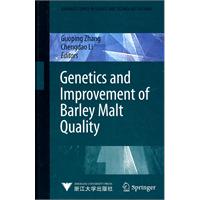內容簡介
Genetics and Improvement of Barley Malt Quality presents up-to-date deVelopments in
 啤酒大麥品質的遺傳和改良
啤酒大麥品質的遺傳和改良ba rley production and breeding.The book is diVided into nine chapters,including barley production and consumption,germplasm and utilization,chemical composition,protejn and protein components,carbohydrates and sugars,starch degrading enzymes,endosperm cell walls and malting quality,genomics and malting quality improVement,and marker-assisted selection for malting quality The information will be especially usefulto barley breeders,malsters,brewers,biochemists,barley quaIity specialists, molecular geneticists,and biotechnologists.rrhis book may also serve as reference text for post-graduate students and ba rley l esearchers.The authors flor each chapter are the experts and frontier researchers in the specific areas.
作者簡介
Professor Guoping Zhang,it's a barley breeder and crop physiologist in Department of Agronom),Zhejiang University of China.D r.Chengdao Li is a senior molecular geneticist and barley breederin Department of Agriculture&Food,Western Australia.He isalso an adjunct professor in Murdoch university of Australia andzhejiang uniVersity of china.
圖書目錄
1 Barley Production and C0nsumption
1.1 Introduction
1.2 World Barlev Production
1.3 World Barlev nade
1.4 World Barley Consumption
1.4.1 Feed ConsumDtion
1.4.2 Maltiing Barley Consumption
1.4.3 Food ConsumDtion
1.4.4 Other Industrial Uses
References
2 Barley Germplasm and Utilization
2.1 Origin and Evolution of Cultivated Barley
2.1.1 The Taxonomv of Barlev
2.1.2 Origin ofthe CultiVated Barley
2.1.3 Evolution and Domestication of Cultivated Barlev.
2.2 Annual Wild Barlev
2.2.1 Annual Wild Barlev in the Near East FIertile Crescent
2.2.2 The Annual Wild Barley in Qing-Tibetan Plateau.
2.2.3 0ther Annual Wild Barley Species
2.2.4 ProsDective
2.3 Perennial Wild Barlev GermDlasm
2.3.1 The Variation of Target naits
2.3.2 ApproachesFBRUtilization of Perennial Wild Barleys.
2.4 Cultivated Barlevs.
2.4.1 Primitive Barlevs 0r Landraces
2.4.2 Commercial Varieties
2.4.3 Mutants
References
3 Chemical Composition in Barley Grains and Malt Quality
3.1 Introduction
3.2 Phvsical Structure
3.2.1 Grain Size
3.2.2 Dormancy
3.2.3 Grain Hardness
3.3 The InterIlal Structure
3.3.1 The Embryo
3.3.2 The Aleurone
3.3.3 The Barley Husk
3.4 The Barley Endosperm
3.4.1 Barley Carbohydrates
3.4.2 Grain Protein
3.5 Malt Quality
3.5.1 Diastatic Power
3.5.2 α-amylase
3.5.3 β-amylaSe
3.5.4 Limit Dextrinase
3.5.5 α-glucosidase
3.5.6 β-glucanase
3.5.7 PrOteinase
3.5.8 Hot Water Extract
3.6 Fleed Barley Quality Traits
3.7 Conclusion
References
4 Identification of Barley、Varieties by Protein Proflling
4.1 Introduction
4.2 Extraction of Proteins for Protein Profiling
4.3 Chalracteristics of Barley Protein Profiles
4.3.1 Peak Size Calling
4.3.2 LOcatiOn and Year
4.3.3 Phylogeny
4.4 Discussion
4.4.1 Specificity of Variety IdeIltification
4.4.2 Location and Year
4.4.3 Malting versus Fleed
4.4.4 Peak Inheritance
4.4.5 C0ntamination
4.4.6 Automation
4.4.7 Conclusion
References
5 β-glucans and Arabinoxylans
6 The Properties and Genetics of Barley Malt Starch
7 The Role of Endosperm Cell Walls in Barley Malting Quality
8 Barley Genomics and Malting Quality Improvement
9 Genetic Improvement of Malting Quality through Conventioal Breeding and Marker-assisted Selection
Index
